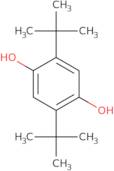
Product Information
- 1,4-Benzenediol, 2,5-bis(1,1-dimethylethyl)-
- 1,4-Dihydroxy-2,5-di-tert-butylbenzene
- 2,5-Bis(1,1-dimethylethyl)-1,4-benzenediol
- 2,5-Bis(2-Methyl-2-Propyl)-1,4-Benzenediol
- 2,5-Di-Tert-Butyl-1,4-Hydroquinone
- 2,5-Di-tert-butyl-1,4-benzenediol
- 2,5-Di-tert-butyl-1,4-benzohydroquinone
- 2,5-Di-tert-butyl-1,4-dihydroxybenzene
- 2,5-Di-tert-butylquinol
- 2,5-Dihydroxy-1,4-di-tert-butylbenzene
- See more synonyms
- 2,5-Ditert-butylbenzene-1,4-diol
- 3,6-Di-tert-butylhydroquinone
- Antage DBH
- Antioxidant Alba
- Antioxidant DBH
- Antioxidant NS 7
- BHQ
- Butylhydroquinone-Tert
- Dbhq
- Dibug
- Dibutylhydroquinone
- Dtbhq
- Hydroquinone, 2,5-di-tert-butyl-
- NSC 11
- NSC 9886
- Naugard 451
- Nocrac NS 7
- Nonflex Alba
- Santovar O
2,5-Di-tert-butylhydroquinone is a potent inhibitor of the two major phospholipases that regulate intracellular Ca2+ levels. It also inhibits epidermal growth factor (EGF) production in rat liver microsomes, and has been shown to inhibit the activity of cytosolic Ca2+/calmodulin-dependent protein kinase II (CAMKII), which regulates cell proliferation. 2,5-Di-tert-butylhydroquinone has also been shown to be a potent inducer of monoclonal antibody production in mice and is used as an adjuvant for the treatment of prostate cancer cells. This compound is metabolized by cytochrome P450 enzymes in liver cells and cardiac cells.
Chemical properties
Technical inquiry about: 3D-FD41543 2,5-Di-tert-butylhydroquinone
If you want to request a quotation or place an order, please instead add the desired products to your cart and then request a quotation or order from the cart. It is faster, cheaper, and you will be able to benefit from the available discounts and other advantages.





